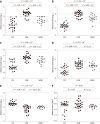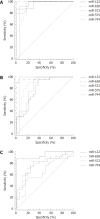Serum levels of microRNAs can specifically predict liver injury of chronic hepatitis B
- PMID: 23066312
- PMCID: PMC3468850
- DOI: 10.3748/wjg.v18.i37.5188
Serum levels of microRNAs can specifically predict liver injury of chronic hepatitis B
Abstract
Aim: To investigate whether circulating microRNAs (miRNAs) can serve as molecular markers to predict liver injury resulted from chronic hepatitis B (CHB).
Methods: The profiles of serum miRNA expression were first generated with serum samples collected from 10 patients with CHB and 10 healthy donors (Ctrls) by microarray analysis. The levels of several miRNAs were further quantitated by real-time reverse transcription polymerase chain reaction with serum samples from another 24 CHB patients and 24 Ctrls. Serum samples of 20 patients with nonalcohlic steatohepatitis (NASH) were also included for comparison. The comparison in the levels of miRNAs between groups (CHB, NASH and Ctrl) was analyzed with Mann-Whitney U-test. The correlation between miRNAs and clinical pathoparameters was analyzed using Spearman correlation analysis or canonical correlation analysis. The receiver-operator characteristic (ROC) curves were also generated to determine the specificity and sensitivity of each individual miRNA in distinguishing patients with CHB from Ctrls.
Results: miRNA profile analysis showed that 34 miRNAs were differentially expressed between CHB and Ctrl subjects, in which 12 were up-regulated and 22 down-regulated in CHB subject (fold change > 2.0 and P < 0.01). The median levels of miR-122, -572, -575 and -638 were significantly higher (P < 1.00 × 10(-5)) while miR-744 significantly lower (P < 1.00 × 10(-6)) in CHB compared with the Ctrl. The levels of miR-122, -572 and -638 were also higher (P < 1.00 × 10(-3)) while the level of miR-744 lower in CHB (P < 0.05) than in NASH, although the difference between them was not as significant as that between CHB and Ctrl. ROC curve analysis revealed that the levels of miR-122, -572, -575, -638 and -744 in serum were sensitive and specific enough to distinguish CHB, NASH and Ctrl. Multivariate analysis further showed that the levels of these miRNAs were correlated with the liver function parameters. Most significantly, it was the scatter plot of principal component with the levels of these miRNAs, but not the parameters of liver function, which clearly distinguished CHB, NASH and Ctrl subjects.
Conclusion: Serum levels of miR-122, -572, -575, -638 and -744 are deregulated in patients with CHB or NASH. The levels of these miRNAs may serve as potential biomarkers for liver injury caused by CHB and NASH.
Keywords: Chronic hepatitis B; Liver injury; Nonalcohlic steatohepatitis; Serum microRNAs.
Figures



Similar articles
-
Expression and significance of urinary microRNA in patients with chronic hepatitis B.Medicine (Baltimore). 2019 Sep;98(37):e17143. doi: 10.1097/MD.0000000000017143. Medicine (Baltimore). 2019. PMID: 31517857 Free PMC article.
-
Profiles of differential expression of circulating microRNAs in hepatitis B virus-positive small hepatocellular carcinoma.Cancer Biomark. 2015;15(2):171-80. doi: 10.3233/CBM-140451. Cancer Biomark. 2015. PMID: 25519019
-
Optimisation of quantitative miRNA panels to consolidate the diagnostic surveillance of HBV-related hepatocellular carcinoma.PLoS One. 2018 Apr 19;13(4):e0196081. doi: 10.1371/journal.pone.0196081. eCollection 2018. PLoS One. 2018. PMID: 29672637 Free PMC article.
-
miRNAs in patients with non-alcoholic fatty liver disease: A systematic review and meta-analysis.J Hepatol. 2018 Dec;69(6):1335-1348. doi: 10.1016/j.jhep.2018.08.008. Epub 2018 Aug 22. J Hepatol. 2018. PMID: 30142428
-
Efficacy of serum miRNA test as a non-invasive method to diagnose nonalcoholic steatohepatitis: a systematic review and meta-analysis.BMC Gastroenterol. 2020 Jun 12;20(1):186. doi: 10.1186/s12876-020-01334-8. BMC Gastroenterol. 2020. PMID: 32532204 Free PMC article.
Cited by
-
Circulating miR-583 and miR-663 Refer to ZHENG Differentiation in Chronic Hepatitis B.Evid Based Complement Alternat Med. 2013;2013:751341. doi: 10.1155/2013/751341. Epub 2013 Mar 10. Evid Based Complement Alternat Med. 2013. PMID: 23554832 Free PMC article.
-
Diagnostic value of circulating miRNA-122 for hepatitis B virus and/or hepatitis C virus-associated chronic viral hepatitis.Biosci Rep. 2019 Sep 6;39(9):BSR20190900. doi: 10.1042/BSR20190900. Print 2019 Sep 30. Biosci Rep. 2019. PMID: 31427483 Free PMC article.
-
A serum microRNA panel as potential biomarkers for hepatocellular carcinoma related with hepatitis B virus.PLoS One. 2014 Sep 19;9(9):e107986. doi: 10.1371/journal.pone.0107986. eCollection 2014. PLoS One. 2014. PMID: 25238238 Free PMC article.
-
Serum microRNAs as potential biomarkers of primary biliary cirrhosis.PLoS One. 2014 Oct 27;9(10):e111424. doi: 10.1371/journal.pone.0111424. eCollection 2014. PLoS One. 2014. PMID: 25347847 Free PMC article.
-
Quantitative methods for optimizing patient outcomes in liver transplantation.Liver Transpl. 2024 Mar 1;30(3):311-320. doi: 10.1097/LVT.0000000000000325. Epub 2023 Dec 25. Liver Transpl. 2024. PMID: 38153309 Free PMC article. Review.
References
-
- World Health Organization. Hepatitis B surveillance and control. Available from: http://www.who.int/csr/disease/hepatitis/whocdscsrlyo20022/en/index4.html.
-
- Custer B, Sullivan SD, Hazlet TK, Iloeje U, Veenstra DL, Kowdley KV. Global epidemiology of hepatitis B virus. J Clin Gastroenterol. 2004;38:S158–S168. - PubMed
-
- Tiollais P, Pourcel C, Dejean A. The hepatitis B virus. Nature. 1985;317:489–495. - PubMed
-
- Bantel H, Lügering A, Heidemann J, Volkmann X, Poremba C, Strassburg CP, Manns MP, Schulze-Osthoff K. Detection of apoptotic caspase activation in sera from patients with chronic HCV infection is associated with fibrotic liver injury. Hepatology. 2004;40:1078–1087. - PubMed
-
- Zeuzem S, Diago M, Gane E, Reddy KR, Pockros P, Prati D, Shiffman M, Farci P, Gitlin N, O’Brien CB, et al. Peginterferon alfa-2a (40 kilodaltons) and ribavirin in patients with chronic hepatitis C and normal aminotransferase levels. Gastroenterology. 2004;127:1724–1732. - PubMed
Publication types
MeSH terms
Substances
LinkOut - more resources
Full Text Sources
Other Literature Sources

